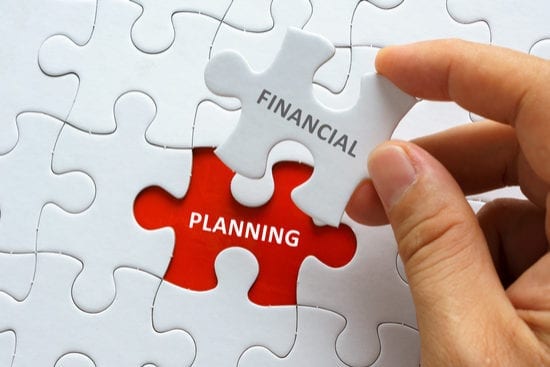What you will learn from reading this article:
- How to start planning for your financial future today
- A financial planning definition that resonates
- Proven personal financial planning strategies
- How to determine how much money you’ll need for retirement
- The Core 4 principles of saving

Whether you have just opened your first IRA account or are nearing retirement, you can always take steps toward planning a stronger financial future. It’s easy to say you need personal financial planning, but how do you get started making a plan that works for you? Creating a financial blueprint will help you understand where you are and where you need to go. Think of it as a map to your financial freedom – a place where your money works for you, and you no longer need to work for your money. Empower yourself with a financial planning definition and strategy tailored to your needs.
What is personal financial planning?
What is financial planning and why is it so important to your future? At its core, a financial plan is the result of examining your goals and helping you prioritize, save and invest for them. An effective financial plan will account for achieving goals that are more short-term, such as buying a new home or starting a business, as well as the long-term goal of retirement. A financial coach or fiduciary can help you determine the steps in financial planning necessary to reach these goals.
Customizing your own financial planning definition
Planning for your financial future is not a one-size-fits-all endeavor. Much like choosing a career path or pursuing a deeply-held dream, personal financial planning is just that – personal. To create a monetary strategy that works, it must align with your ultimate purpose in life. To create a meaningful financial planning definition, remember that life is not a competition. Don’t think you can do the same thing your coworker or sibling did with their financial resources and get the same results. While it’s sometimes beneficial to search for financial plan examples for guidelines, don’t just copy someone else’s strategy. You need to create a financial plan that meets your needs and goals, not anyone else’s. A plan that meets your needs, works for you and that you stick to – that’s success. Figuring out what you really want from life and setting up the correct financial planning tools needed to meet that desire will help you create a clear path toward financial freedom. Here’s how to get started:
Guiding principles in personal financial planning
Finding answers to the question, “What is financial planning?” is a process of self-discovery. Here are several guiding principles to get you started:
Commit to honesty in financial planning
If you try to build a financial plan that prohibits any fun spending for 10 years, you won’t stick with it, no matter what financial planning tools you use. Instead, take an honest measurement of where you are now and an objective assessment of where you want your finances to be. This will help you develop effective steps in financial planning. For instance, if you know you enjoy taking a vacation each year, account for that. Don’t try to convince yourself that you can forego one for 10 years – that’s bad for your sense of well-being and is not realistic. Eventually, you’ll cave and go on an extravagant trip instead of taking a more reasonable getaway annually. And if you do adhere to that strict rule, you will be neglecting the self-care that must accompany any successful plan.

Decide on your personal financial planning number

How much money do you need to be financially secure, independent or free? What are your goals for your financial future, and how much money will it take to reach them? Take a guess and go with your gut – write that number down somewhere right now.
For most people, that number usually feels large. But keep going – some analysis will give you the financial planning advice you need to make your financial dreams a reality.
Evaluate where you are now
To make sure your number is accurate, you must figure out your current financial situation. First, map out what you need for financial security. How much do you pay a month for:
- Your home (mortgage or rent)
- Your utilities
- Food
- Transportation
- Insurance
For most of us, these five categories make up about 65% of our expenses. Take how much you pay per month, add them up and multiply by 12 – now you have what you’ll need as annual income to achieve financial security. Think of this as step #1 of your personal financial planning journey.

For some context, the US average for basic annual expenses is $34,668. With some financial planning, it’s likely you’ll be able to pay for your basics by creating a money machine that harnesses the power of compounding interest along with an automated savings plan.
Step #2 involves figuring out what you spend on clothing, dining, entertainment and your small indulgences or luxuries (anything from a magazine subscription to monthly massage can go in this category). Multiply that by 12 and add to your basics. Armed with this info, you’ll get to the number that will ensure your financial security. A few more calculations will let you plan how much you need to retire.
Now that your financial planning tools are in place, it’s time for action.
Steps in financial planning
What is personal financial planning without some effective strategies to attain your goals and free yourself of financial fear? Here are some that are proven to work.
Financial planning tip #1: Undergo a financial detox
When you’re getting started creating a financial planning strategy, it’s wise to undergo what Tony Robbins calls a financial detox. Think about your physical health. If you’re working on losing weight and getting in shape, it’s tempting to begin a radical new diet and train for a marathon. But in reality, these steps are too extreme for someone just starting out. You’ll need to detoxify your body to prepare it for bigger and better gains. Mastering your finances is similar. Before you become financially independent, you’ll need to “detox” by learning how to spend (and save) your money wisely. Your detox is one of the preliminary steps in financial planning that will prepare you to go the distance. A financial detox has 6 steps:
1. Create a spending plan
Rather than spending your money haphazardly, make a plan for how you want to use your resources. Don’t think of your financial planning strategy as a restrictive diet – think of it as a plan for optimizing your resources to meet your deepest needs. When you’re conserving your money for what’s really important to you, saving becomes more natural.
2. Pay yourself first
You pay for your bills, but are you making sure that you’re establishing your future with a percentage of each paycheck? Commit to your own personal financial planning by paying yourself first. By saving a small percentage of your income, you’ll create a nest egg that adds up quickly. Saving $40 a week helps you save around $2,000 a year. But the trick is to automate this percentage so that you don’t even know you’re saving it. Maybe it’s 3% or 10% – maybe more.
If you get direct deposit through your employer, you can usually split your earnings into different accounts. Take advantage of this feature so you don’t need to spend time doing it manually – and so you’re not tempted to skip it. Otherwise, create an automatic transfer from your checking or other main account into your savings.
3. Find a fiduciary partner
Even with a financial planning definition that resonates with you in place, you’ll have trouble sticking to your plan without support. A fiduciary partner is an ideal source of guidance, since a fiduciary is legally required to prioritize your needs above their own. You’ll receive monetary advice that’s tailored to you, independent of anyone else.
4. Sell poor-quality mutual funds
If your mutual funds aren’t benefiting your portfolio, sell them. You’ll rid yourself of high fees and low returns so you’re free to pursue higher-yielding options.
5. Understand your risk tolerance
Your attitude toward financial risk is unique to your psychology and the strength of your assets. When you understand your risk tolerance, you’re better able to allocate your assets so they benefit you in the long run.
6. Embrace abundance
Like all of life, effective personal financial planning relies on embracing an abundance mindset. When your thinking is based on passion, drive, and confidence, you’re able to plan for a future you will love. Become the master of your own feelings and thoughts and you’ll be on your way to the top.
Financial planning tip #2: Build a money machine
If you harness the power of compounding – making your money work even when you’re not on the clock – you’ll see incredible returns over the long term and make your personal financial planning much more effective. It can be hard to visualize the results, but with your number in mind, you’re ready to realistically think big.
Financial planning tip #3: Follow the Core 4
These fundamental principles of personal financial planning help you make the most of your savings, no matter their size or your stage in life.
1. Protect the principal interest as much as possible
2. Take only asymmetric risks
3. Be tax efficient
4. Be well-diversified
Much of the Core 4 strategy for building a financial plan depends on diversification. Think of your investments as going into three buckets – we also call this asset allocation. By mixing up your types of assets and where those assets live, you’ll decrease your risk and increase your eventual returns. Turns out the saying “don’t put all your eggs in one basket” actually is good advice for a solid financial future.
Looking for a more detailed breakdown of the Core 4? If you haven’t already, go learn more about the Core 4 and how it can work for you.
With a personalized financial planning definition and strategy in place, you’re ready to take control of your finances. Accelerate your progress with Tony Robbins’ Unshakeable: Your Financial Freedom Playbook. You’ll learn how to diversify your assets, invest wisely and master your monetary future.
Ready to build a financial plan for your future?
Learn crucial financial planning tactics, including asset diversification and strategic investing, with the help of Tony Robbins’ Unshakeable audio.